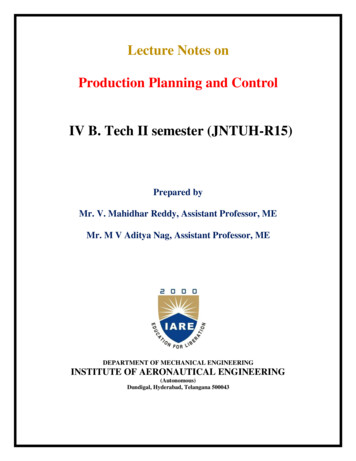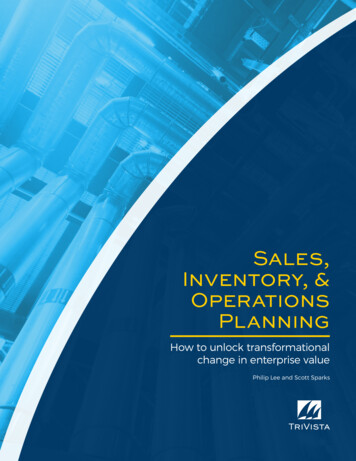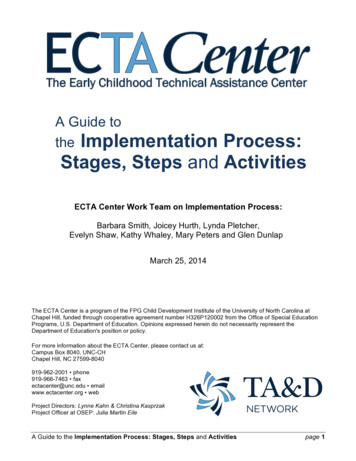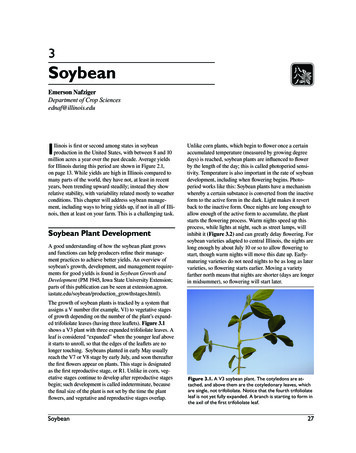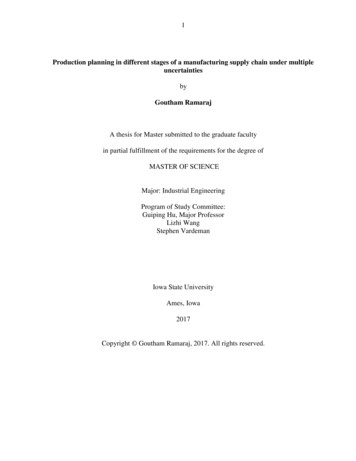
Transcription
1Production planning in different stages of a manufacturing supply chain under multipleuncertaintiesbyGoutham RamarajA thesis for Master submitted to the graduate facultyin partial fulfillment of the requirements for the degree ofMASTER OF SCIENCEMajor: Industrial EngineeringProgram of Study Committee:Guiping Hu, Major ProfessorLizhi WangStephen VardemanIowa State UniversityAmes, Iowa2017Copyright Goutham Ramaraj, 2017. All rights reserved.
ii DEDICATIONIn dedication to my family for their unconditional support.
iiiTABLE OF CONTENTSPageACKNOWLEDGMENTS .ivABSTRACT . .vCHAPTER 1 GENERAL INTRODUCTION .References .15CHAPTER 2 A TWO-STAGE STOCHASTIC PROGRAMMING MODEL FORPRODUCTION LOT-SIZING AND SCHEDULING UNDER DEMAND AND RAWMATERIAL QUALITY UNCERTAINTIES.6Abstract.62.1 Introduction .72.2 Problem statement. 122.3 Model formulation . 142.3.1 Mathematical notations . 142.3.2 Deterministic model . 14Objective function . 15Constraints . 172.3.3 Two stage stochastic programming model . 202.4 Case study . 222.4.1 Data sources . 232.4.2 Scenario generation and reduction . 27Scenario generation . 27Scenario reduction . 312.4.3 Analysis for the deterministic case . 332.4.4 Analysis for the stochastic case . 352.5 Conclusion . 40References . 41CHAPTER 3 PRODUCTION PLANNING WITH A TWO-STAGE STOCHASTICPROGRAMMING MODEL IN A KITTING FACILITY UNDER DEMAND AND YIELDUNCERTAINTIES. . 47Abstract. 473.1 Introduction . 483.2 Problem statement . 543.3 Model formulation . 553.3.1 Mathematical notations . 553.3.2 Deterministic model . 56Objective function and constraints. 573.3.3 Two stage stochastic programming model . 603.4 Case study . 633.4.1 Data sources . 633.4.2 Scenario generation and reduction . 67
ivScenario generation .Scenario reduction .3.4.3 Analysis for the deterministic case .3.4.4 Analysis for the stochastic case .3.5 Conclusion .References .687375778182CHAPTER 4 CONCLUSION .87
vACKNOWLEDGMENTSI would like to take this opportunity express my profound sense of gratitude to those whohave helped me throughout my research work and the writing of this thesis.First and foremost, my major professor, Dr.Guiping Hu, for her guidance and continuoussupport throughout the completion on this thesis. Her timely advice, meticulous scrutiny, andscientific approach have helped me to a very great extent to accomplish this task. Theconversations that we had during our weekly meetings not only helped to get invaluablefeedback on my work but also provided me immense motivation for completing my graduateeducation.I would also like to thank my committee members, Dr.Lizhi Wang and Dr. StephenVardeman for their guidance and support throughout the course of this research. I would like tothank Zhengyang Hu, my research partner, for taking out time from his busy schedule to meetwith me and for providing valuable feedback on my work.In addition, I would also like to thank my family of friends, and the department facultyfor making my time at Iowa State University a wonderful experience. Most importantly, I wouldlike to thank my parents, my brother and my fellow-cyclone, Aparna Sahajan, for yourunconditional love, support and much needed encouragement. You guys have helped me learnthat nothing is beyond the reach of our dreams.
viABSTRACTThis thesis focuses on designing stochastic programming models for production planningat different stages in a manufacturing supply chain under multiple sources of uncertainties.Various decision makers along the manufacturing supply chain often have to make planningdecisions with embedded risks and uncertainties. In an effort to reduce risks and to ensure thatthe customer demand is met in the most efficient and cost effective way, the production plans ateach stage need to be strategically planned. To assist production planning decisions, a two-stagestochastic programming model is developed with the objective of minimizing the total costincluding production, inventory, and backorder costs. The proposed framework is validated withcase studies in an automobile part manufacturer with real data based on literature. The resultsdemonstrate the robustness of the stochastic model compared with various deterministic models.Sensitivity analysis is performed for the production capacity parameter to derive managerialinsights regarding lot-sizing and scheduling decisions under different scenarios.
1CHAPTER 1. GENERAL INTRODUCTIONProduction planning is important in a manufacturing facility to ensure efficient, andeffective utilization of resources. It typically involves sequencing and scheduling the productionbatches, determining the optimal batch quantities and prioritizing the batches. In reality, theplanning of the production processes is often conducted under a variety of uncertainties, such asdemand, machine availability, worker efficiency, etc. Therefore, it is important to take theuncertainties into consideration when making the production decisions.There has been significant body of literature on production planning in manufacturingsystems under uncertainty. Ho categorizes the uncertainties observed in manufacturing systeminto environmental and system uncertainties [1]. While environmental uncertainties includedemand and supply uncertainties, production system uncertainties are related to the productionprocesses itself, such as machine availability, operational yield, and production qualityuncertainties. Different strategies for modelling the production planning processes underuncertainty have been developed and applications in a variety of industries have been discussedin the literature [2, 3, 4].The modelling framework in the literature can be categorized into four classes ofconceptual, analytical, artificial intelligence, and simulation models which was originallyproposed by Giannoccaro and Pontrandolfo [5]. The analytical models used for productionplanning are based on different operations research techniques, mainly linear programming,stochastic programming, mixed integer programming, Markov decision process, and multiobjective programming. The areas of application, as identified by Mula et al., include capacity
2planning, manufacturing resource planning, inventory management and supply chain planning[6].Production planning involves a number of stakeholders spanning across themanufacturing supply chain such as raw material suppliers, manufacturers, distributors, andcustomers. Figure 1 shows the schematic of the supply chain of a typical automobilemanufacturer. All the stages are inter-connected that the uncertainties in a stage can influence theoperations planning and decision-making in another stage. For example, an uncertainty in thequality or the lead time of the parts to be assembled could impact the production sequence due toparts availability. This disrupts the production planning at the assembly line feeding system astheir operations are planned according to the initial production plan.In the existing literature, production planning studies have been focused on themodelling approaches and the application areas, the stages along a manufacturing supply chainhave not been studied carefully. In this thesis, we address the problem of production planning indifferent stages in the manufacturing system under a variety of uncertainties. We also highlighthow the uncertainties propagate across different stages and highlight how they influence thebusiness decisions in these stages.Figure 1: Supply chain of a typical automobile manufacturer
3To gain a better understanding of production planning under uncertainty and to providea foundation for the research, we briefly discuss some existing literature. Kitting system, whichis a part of stage 1 of the supply chain, is one of the most widely used assembly line feedingsystem. Som et al. analyzed the kitting process of a multi-product, multi-level assembly systemunder uncertainty. They derived the processes that describe the input and output streams of theassembly system. The distribution of time between the kit completions was also derived [7].Leung and Wu developed a robust optimization model to solve the aggregate productionplanning problem under uncertainty. They also presented the analysis of the tradeoff betweensolution and model robustness [8]. This study would apply to stage 2 in the manufacturingsupply chain discussed above. Gupta and Maranas proposed an approach based on stochasticprogramming for managing demand uncertainty in supply chain planning. In their proposedframework, the decisions related to manufacturing (Stage 2) were the here and now decisionsand the logistic decisions (Stage 3) were modeled as the wait and see decisions. The key featuresof their model were highlighted through a case study [9].Many researchers have worked on both the deterministic and the stochastic versions ofthe decision-making models for production planning. Two-stage stochastic programmingmodeling approach has not been utilized extensively, which is a major motivation for this study.Modelling the production planning problems using a two-stage stochastic programmingframework is one of the major contributions of our work. We are among the pioneers to adopt atwo-stage stochastic programming framework to solve lot-sizing and scheduling problems atdifferent stages along a manufacturing system. Through the proposed mathematical framework,we also highlight how the uncertainties affect the decision-making process in different stages ofa supply chain.
4In this thesis, we aim to fill in the gaps in studies related to production planning underuncertainty in a manufacturing environment. Through our study, we propose a two-stagestochastic programming framework for planning the production process at different stages in thesupply chain. The objective is to minimize the total costs such that the downstream customerdemands are met in the most efficient and cost effective way.The remainder of the thesis is structures as follows: Chapter 2 provides a model forproduction lot-sizing and scheduling under demand and raw material quality uncertainties. Acomparison of the implementation results from the deterministic and the stochastic models isalso presented. In Chapter 3, we present a modelling approach to plan the production processesin an assembly line feeding kitting facility under demand and yield uncertainties. The influenceof the uncertainties on the business decisions is also highlighted and discussed. Conclusions ofthe thesis and some future research directions are provided in Chapter 4.
5REFERENCES[1]C.-J. Ho, “Evaluating the impact of operating environments on MRP systemnervousness.,” International Journal of Production Research, vol. 27, no. 7, p. 1115, 1989.[2]B. Porter, K. L. Mak, and Y. S. Wong, “Machine requirements planning andworkload assignment using genetic algorithms,” in Proceedings of 1995 IEEE InternationalConference on Evolutionary Computation, 29 Nov.-1 Dec. 1995, 1995, vol. vol.2, p. 711.[3]N. Koutsoukis, B. Dominguez‐ Ballesteros, C. A. Lucas, and G. Mitra, “Aprototype decision support system for strategic planning under uncertainty,” InternationalJournal of Physical Distribution & Logistics Management, vol. 30, no. 7/8, pp. 640–661, 2000.[4]J. Xie, X. Zhao, and T. S. Lee, “Freezing the master production schedule undersingle resource constraint and demand uncertainty,” International Journal of ProductionEconomics, vol. 83, no. 1, pp. 65–84, 2003.[5]I. Giannoccaro and P. Pontrandolfo, “Models for supply chain management: ataxonomy,” Proceedings of the Twelfth Annual Conference of the Production and OperationsManagement Society, POM-2001, p. 16, 2001.[6]J. Mula, R. Poler, G. S. García-Sabater, and F. C. Lario, “Models for productionplanning under uncertainty: A review,” International Journal of Production Economics, vol.103, no. 1, pp. 271–285, 2006.[7]P. Som, W. E. Wilhelm, and R. L. Disney, “Kitting process in a stochasticassembly system,” Queueing Systems, vol. 17, no. 3, pp. 471–490, 1994.[8]S. C. H. Leung and Y. Wu, “A robust optimization model for stochastic aggregateproduction planning,” Production Planning & Control, vol. 15, no. July, pp. 502–514, 2004.[9]A. Gupta and C. D. Maranas, “Managing demand uncertainty in supply chainplanning,” Computers and Chemical Engineering, vol. 27, pp. 1219–1227, 2003.
6CHAPTER 2. A TWO-STAGE STOCHASTIC PROGRAMMING MODEL FORPRODUCTION LOT-SIZING AND SCHEDULING UNDER DEMAND AND RAWMATERIAL QUALITY UNCERTAINTIESModified from a paper to be submitted to Production Planning and ControlGoutham Ramaraj, Zhengyang Hu and Guiping HuAbstractProduction planning and scheduling focus on efficient use of resources and are widelyused in the manufacturing industry, especially when the system operates in an uncertainenvironment. The goal of this paper is to provide a two-stage stochastic programming frameworkfor a multi- period, multi-product, lot-sizing and scheduling problem considering uncertainties inboth demand and the quality of raw materials. The objectives are to determine the number ofunits to be produced and the production sequence so that the total production costs areminimized. The decisions made in the first stage include the basic production plan along with theproduction quantities and sequences, which are later updated with recourse decisions onovertime production made in the second-stage. To demonstrate the proposed decision-makingframework, a case study for a manufacturing facility producing braking equipment for theautomotive industry was conducted. The results show that the stochastic model is more effectivein production planning under the uncertainties considered. The managerial insights derived fromthis study will facilitate the decision-making for determining optimal production quantities andsequences under uncertainties.Keywords: Production planning, lot-sizing and sequencing, stochastic programming, demanduncertainty, quality uncertainty
72.1 IntroductionProduction planning plays an important role in improving overall manufacturing systemperformance, especially when a system operates in an uncertain environment. Uncertainty inproduct demand, processing time, and quality of raw materials are among the common types ofuncertainties that characterize production environments. To develop a robust production plan, itis important that the uncertain parameters are considered in the production planning process,because neglecting them will affect production efficiency and system performance [1]. Thisresearch focuses on a multi-period, multi-product, lot-sizing and scheduling problem underuncertainty.The planning horizons for the decision-making process in production planning models aretypically classified into three categories: long-term, medium-term, and short-term planning.Long-term planning primarily focuses on strategic long-term decisions such as equipment,product, and process choices whereas medium-term and short-term planning involve makingdecisions on material flow, and production lot-sizing and sequencing for optimizing overallperformance. Typically, the time range for the short-term decisions is within a day [2]. In thispaper, our focus is on the production lot-sizing and scheduling problem, which can be classifiedas short-term to medium-term production planning.Many studies have been conducted by researchers over the years to solve the production lotsizing and scheduling problem using a variety of techniques. The classical economic orderquantity (EOQ) model marked the start of research on lot-sizing problems [3,4]. To bridge thegaps in the EOQ model, like stationary demand and no capacity constraints, other models likethe economic lot scheduling problem (ELSP) and the Wagner-Whitin problem (WW) evolved[5]. While the ELSP considers an infinite planning horizon with capacity restrictions, WWassumes a finite planning horizon with dynamic demand. The latest models that have combined
8both the capacitated and the dynamic lot-sizing approaches include the discrete lot-sizing andscheduling problem (DSLP), the continuous lot-sizing and scheduling problem (CSLP), theproportional lot-sizing and scheduling problem (PLSP), and the general lot-sizing and schedulingproblem (GSLP). DSLP works with the assumption that not more than one product can beproduced per period which is not present in CLSP. PLSP overcomes the limitation of CLSP byusing the remaining capacity for scheduling a second product within the same period. GSLPdeals with the lot-sizing and scheduling of several products on a single capacitated machine [2].Some of the characteristics, as identified by Karimi et al., that influences the modelling and thecomplexity of lot-sizing and scheduling models include number of levels in a production system,number of products manufactured, demand and capacity constraints [2]. To classify the differentmodeling approaches used for lot-sizing and scheduling problems, Guimaraes et al. presented anew framework as shown in Figure 2 [6]. The discrete time models for lot-sizing and schedulingare classified based on two main dimensions: technique and time structure. The different classeswithin these dimensions are defined by both the technique and time structure used. The two mainapproaches based on the first dimension are product oriented (PO) and sequence oriented (SO)formulations. Based on the dimension of time structure, the framework classifies the models intomicro-period (mP) and macro-period models (MP). Multiple setups are allowed in MP models,while mP models allow only a single setup per micro-period. The framework further classifiesthe models into single lot (SL) and multiple lot (ML), based on the number of production lots ofeach product allowed to start within a time period. In our paper, the sequence of production lotsin a machine is modeled as per the product oriented, single lot, macro-period model. To depict anexample, consider the production sequence {1-4-3-2} as shown in Figure 3. If a macro-periodmodel is used, the following setups will be selected to establish the production sequence: (1-4)(4-3) (3-2). Setup (1) was carried over from the previous period, and setup (2) will be carried
9over to the next period. Whereas for a micro-period model each setup state of (1) (2) (3) (4)would be captured separately to establish the changes in the sequences.Figure 2: Classification framework for lot-sizing and scheduling problems [6]There is significant body of literature on the topic production lot-sizing and scheduling.The solution techniques and their application on real-world problems have been discussed invarious industries such as textiles, beverages, tobacco, paper, and pharmaceuticals. Araujo et al.developed a mixed-integer programming model for solving the lot-sizing and schedulingproblem in a manufacturing setting considering the sequence-dependent costs and times [7].Almada et al. proposed a mixed integer programming formulation to solve a short-termproduction planning and scheduling problem in a glass container industry. They used aLagrangian decomposition based heuristic for generating good feasible solutions [8]. Silva andMagalhaes studied a discrete lot-sizing and scheduling problem found in the textile industry.They presented a heuristic approach for minimizing tool changeovers and the quantity of theproduct delivered after a due date [9]. In Gnoni et al. a hybrid modeling approach was used tosolve a production planning problem of a manufacturing plant producing braking equipment. Thedeveloped hybrid model was comprised of a mixed-integer linear programming model and asimulation model [10]. Marinelli et al. proposed a robust optimization model for a capacitatedlot-sizing and scheduling problem in a packaging company producing yoghurt. They developed
10an effective two-stage optimization heuristic for scheduling orders on a production line based onreal data from a company [11]. In Diaby et al., a robust mixed-integer linear programming modelwas formulated and solved using Lagrangean relaxation to address the capacitated lot-sizing andscheduling problem [12]. Chen et al. proposed a robust optimization model for schedulingindependent jobs on parallel machines to minimize makespan. Significant improvement from theexisting algorithms was reflected in the computational tests performed [13].Figure 3: Example of production sequence path [6]Application of deterministic and stochastic versions of mathematical models have beenpopular among the researchers studying production lot-sizing and scheduling problem. But veryfew have discussed the application of stochastic programming to these problems underuncertainty. Escudero et al. solved a multi-period, multi-product production planning problemwith random demand using a multi-stage stochastic model [14]. Leung and Wu developed arobust optimization model to determine optimal production loading plan and workforce level foran aggregate production planning problem in an uncertain environment. The costs involved withproduction, labor, inventory, hiring and layoff were considered for the study [15]. In the studyconducted by Bakir and Byrne a stochastic linear programming model based on a two-stagedeterministic equivalent problem was used for addressing a multi-period, multi-productproduction planning problem with stochastic demand [16]. Hu and Hu studied the application ofa two-stage stochastic programming framework for solving a lot-sizing and scheduling problem
11in an automotive part manufacturing plant [17]. Unlike the study conducted by Hu and Hu, ourstudy models the dynamics of multiple uncertainties in a manufacturing environment, which ismore practical. The two uncertainties are modelled separately and integrated into the two-stagestochastic programming model to aid better decision-making. We also discuss how the recourseactions gets influenced by the presence of multiple uncertain parameters in the model.Brandimarte developed a multi-stage mixed-integer stochastic programming model for solving amulti-item capacitated lot-sizing problem with uncertain demand. They also tested theadvantages of a stochastic model over a deterministic one by conducting computationalexperiments [18]. Khor et al. studied the capacity expansion problem in petroleum refinery underuncertainty using a two-stage stochastic programming model and robust optimization models[19].In the literature on production planning under uncertainty, typically only one uncertainfactor is considered. In practice, there can be more than one uncertain factor, each with their owndynamics and behavior over time that can have an impact on the recourse decisions made in amanufacturing environment. Kazemi et al. proposed a multi-stage stochastic programmingapproach for a production planning problem with uncertainties in both demand and the quality ofthe raw materials. A hybrid scenario tree was developed by integrating the demand and the yieldscenarios to formulate a stochastic programming model with full recourse for demand and simplerecourse for yield [20]. Unlike our problem, the study conducted by Kazemi et al. does notinclude determining the overtime production quantities and the optimal production sequence.Although Mukhopadhyay and Ma developed a two-stage stochastic model to understand how afirm’s procurement and production decisions are influenced by demand and quality uncertainties,their study did not involve any decision-making regarding production lot-sizing and scheduling[21]. The novelty of this study lies in integrating two different uncertainties (demand and quality
12of raw materials) to be used in a two-stage stochastic programming model to solve a productionlot-sizing and scheduling problem in a manufacturing setting. The application of two-stagestochastic programming framework to tackle the lot-sizing and scheduling problem underuncertainty can be regarded as another major contribution of this paper as not many studies havediscussed this application.The remainder of the paper is organized as follows. In the next section, the problemstatement for the lot-sizing and scheduling is presented. In section 3 we describe a deterministiclinear programming model and the two-stage stochastic programming model for production lotsizing and scheduling with random demand and raw material quality. In section 4, the applicationof the developed framework to a case study for an automotive part manufacturer is presentedalong with the comparison of computational results from both models. Our concluding remarksand further research directions are discussed in section 5.2.2 Problem StatementProduction planning and scheduling are important tools that provide decision support forproduction activities in the manufacturing industry. The presence of uncertainties, which arecommon in most production environments, make the decision-making processes complex andchallenging.A typical manufacturing system schematic is shown in Figure 4. Raw materials are collectedand accumulated at internal/external warehouses of the manufacturing plant. They are thenshipped to the assembly line to be processed and assembled to produce final products forcustomers. These finished products are then transported to downstream sites or directly tocustomers.
13Figure 4: Manufacturing system under studyAs Ho [22] discussed, the uncertainty that affects production processes in the real wordcan be both system and environmental. Environmental uncertainty is related to uncertaintiesbeyond the production process, such as demand and supply uncertainty. System uncertaintyincludes uncertainties within the production process, such as lead time, quality, and yielduncertainties. The planning of the production process in a manufacturing plant is highlydependent on the demand for manufactured products from customers. The availability of qualityraw materials from suppliers is also of vital importance to strike a balance between the inboundmaterials and outbound products. Neglecting these uncertainties in production planning willresult in unsatisfactory and inefficient production plans.The goal of this paper is to provide a two-stage stochastic programming framework for theproduction lot-sizing and scheduling problem considering uncertainties in both demand and thequality of raw materials. The results from this paper will facilitate the decision-making fordetermining optimal production quantities and sequences under uncertainties.
142.3 Model FormulationIn this section, the deterministic and the stochastic versions of the model for the productionplanning problem studied are introduced. The objective is to determine the number of units to bepr
planning, manufacturing resource planning, inventory management and supply chain planning [6]. . Production planning and scheduling focus on efficient use of resources and are widely used in the manufacturing industry, especially when the system operates in an unce


